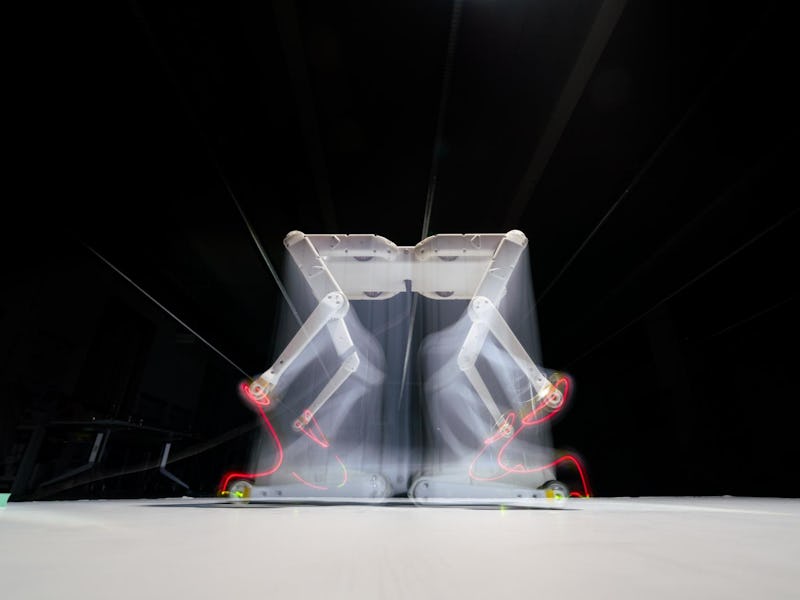Video: This new robotic dog promises to be the robot of the people
Finally, a robot dog for the everyman

The most cutting edge robots today can open doors, dance to music, and perform acts of remarkable dexterity. They are also very, very expensive.
Tha's why NYU Tandon School of Engineering has designed a budget-friendly robot dog that has many of the same capabilities and agility of its pricier counterparts for only a fraction of the cost. The design is completely free and open-source on GitHub and can be easily 3D printed by labs across the world and assembled using off-the-shelf components.
It's even so rugged and durable that the researchers say this robotic pup can be tossed into a backpack and easily carried to conferences or field testing sites.
"Within a few extra weeks... you’ve got yourself a world-class robot.”
Robotic "dogs" like Boston Dynamics' Spot have been becoming increasingly common in recent years, but the price of these robots for academic institutions, let alone individuals, have stayed incredibly high. A typical price for these robots is at least $50,000 with Boston Dynamics' recent public release of its Spot robot costing over $70,000.
But in a study accepted for publication in the journal Robotics and Automation Letters and to be presented at the (virtual) International Conference on Robotics and Automation later this month, engineers from NYU Tandon describe how they were able to design a light-weight and inexpensive robot -- dubbed Solo 8 -- without sacrificing important agility and functionality.
"For an open-source legged robot to be successful, it is necessary to minimize the number of parts requiring precision machining, thereby favoring off-the-shelf components over sophisticated custom actuation solutions," write the authors. "To achieve this goal, we leverage recent advances in inexpensive plastic 3D printing and high-performance brushless DC motors (BLDC) which are now widely available as off-the-shelf components."
Solo 8 can jump more than double its own height -- over two feet.
Like its more expensive counterparts, such as MIT's Cheetah or Boston Dynamics' Spot, Solo 8 resembles a running table more than it does a loveable dog. But what it lacks in cuteness, it makes up for in power. Solo weighs in at less than five pounds, giving it a superior power to weight ratio over its competition. This, as well as the robot's torque-controlled motors, gives it extra mobility and range of motion. For example, the authors write that Solo can be knocked on its back and simply rotate its legs 180 degrees in order to stand back up.
And more than just agile, Solo is also significantly cheaper than similar models at a little less than $4,500. Compared to the Spot models recently released by Boston Dynamics for commercial use, Solo 8 is less than a tenth of the price.
According to Ludovic Righetti, lead researcher on the project and Associate Professor in the Electrical and Computer Engineering Department, this price and size reduction is a huge step toward making these kinds of complex robotics available to academic institutions at a much more accessible price point.
"Our robot platform is a great base to quickly prototype and build high-performance hardware,” Righetti said in a statement. “It greatly simplifies our research, and our open-source approach allows us to compare algorithms with other laboratories. In my lab here in New York, we have developed very efficient motion optimization algorithms, but testing them on a complex, heavy robot can easily take half a year of work for several researchers, while this can be done more easily with Solo. That was a big deal for us.”
Small but resilient, Solo 8 can stand right back up after being flipped on its back.
Another aspect of Solo's accessibility, write the authors in the study, is that it can be customized by different research groups to complete tasks beyond the scope imagined by Righetti and his team.
Being able to customize these robot dogs will enable much faster research with them, including locomotion tests, environment manipulation tests (like opening doors,) and even parkour.
"For a research group to develop such a robot themselves, it takes easily four years of work,” said Alexander Badri-Spröwitz, a co-author of the study, in a statement. “Now any lab worldwide can go online, download the files and print the parts, and buy the remaining components from the catalog. And everybody can add extra features, within a few extra weeks. Done – you’ve got yourself a world-class robot.”
(Pre-print) Abstract: We present a new open-source torque-controlled legged robot system, with a low-cost and low-complexity actuator module at its core. It consists of a high-torque brushless DC motor and a low-gear-ratio transmission suitable for impedance and force control. We also present a novel foot contact sensor suitable for legged locomotion with hard impacts. A 2.2 kg quadruped robot with a large range of motion is assembled from eight identical actuator modules and four lower legs with foot contact sensors. Leveraging standard plastic 3D printing and off-the-shelf parts results in a lightweight and inexpensive robot, allowing for rapid distribution and duplication within the research community. We systematically characterize the achieved impedance at the foot in both static and dynamic scenarios, and measure a maximum dimensionless leg stiffness of 10.8 without active damping, which is comparable to the leg stiffness of a running human. Finally, to demonstrate the capabilities of the quadruped, we present a novel controller which combines feedforward contact forces computed from a kino-dynamic optimizer with impedance control of the center of mass and base orientation. The controller can regulate complex motions while being robust to environmental uncertainty.